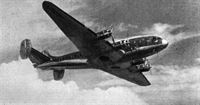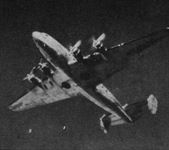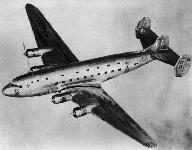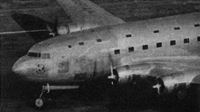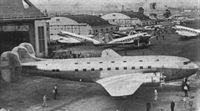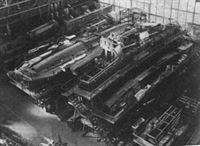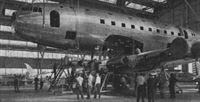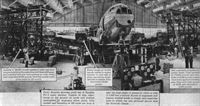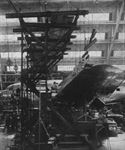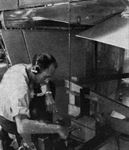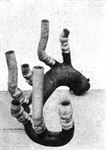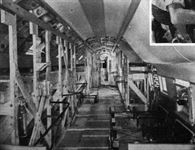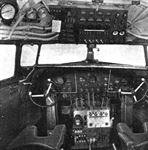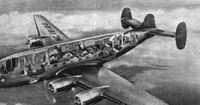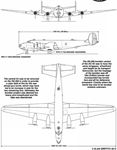
Описание
Страна : США
Год : 1938
Единственный экземпляр
Four-engined commercial transport
Варианты
- Douglas - DC-4E - 1938 - США
- Nakajima - G5N Shinzan - 1941 - Япония
Douglas DC-4E
Под первоначальным обозначением DC-4, которое быстро было изменено на DC-4E ("E" - экспериментальный), компания "Douglas" спроектировала и построила прототип нового авиалайнера большой вместимости, который должен был прийти на смену DC-3. Этот весьма дорогостоящий проект финансировался совместно "Douglas" и пятью американскими авиакомпаниями (каждая из сторон внесла по 100000 долларов). DC-4E представлял собой низкоплан цельнометаллической конструкции с большим фюзеляжем почти круглого сечения, с трехкилевым хвостовым оперением и трехопорным шасси, основные опоры которого имели по одному большому колесу и убирались в крыльевые ниши. Силовая установка включала четыре звездообразных двигателя R-2180, установленных в крыльевых гондолах.
Прототип совершил первый полет 7 июня 1938 года. К тому времени две авиакомпании - "Pan American" и TWA - вышли из проекта, а характеристики и стоимость эксплуатации авиалайнера оказались хуже ожидаемых. В конечном итоге руководство "Douglas" и оставшихся в проекте трех авиакомпаний - "American", "Eastern" и "United" - решили переориентироваться на создание другого самолета, который был бы менее сложным и дорогостоящим в производстве и эксплуатации. В результате этого решения вскоре появилось семейство самолетов DC-4 и C-54, а единственный прототип DC-4E был чуть позже продан в Японию, где получил обозначение LXD1 и использовался компанией "Nakajima" в процессе создания тяжелого бомбардировщика G5N.
- Описание
Фотографии
-
Aviation Historian 28 / A.Griffith - Ploughshares into Swords
Регистрационный номер: NX18100 [22] The prototype - and only - DC-4E takes off on its first flight, in the hands of test pilot Carl Cover, from Clover Field, Santa Monica, California, on June 7, 1938. The “E” suffix was retrospectively applied to the aircraft after Douglas started work on its new DC-4 design in mid-1939.
-
Мировая Авиация 114
Регистрационный номер: NX18100 [22] "Douglas" отказалась от реализации проекта DC-4E из-за высокой сложности и стоимости производства и эксплуатации. Самолет имел трехкилевое хвостовое оперение.
-
Jane's All the World Aircraft 1938 / 03 - All the world's aeroplanes
Регистрационный номер: NX18100 [22] The Douglas DC-4 Forty-two-passenger Commercial Transport (four 1,150 h.p. Pratt & Whitney "Twin-Hornet" engines).
-
Flight 1938-11 / Flight
Регистрационный номер: NX18100 [22] HALF-POWER: The Douglas D.C.4 flying on two engines; the other two have been stopped with the help of the full-feathering airscrews. In this form the D.C.4 has a ceiling of 11,000ft. on full load. Very shortly the machine will be taken over in turn by various American operators for service trials.
-
Flight 1940-03 / Flight
Регистрационный номер: NX18100 [22] "... let us see, the D.C.4 can hardly be truly new."
-
Мировая Авиация 205
Регистрационный номер: NX18100 [22] "Douglas" построила всего один прототип DC-4E. Получивший регистрационный номер NC18100, он был продан японской компании "Dai Nippon Koku" в 1939 году. Позднее сообщалось, что машина упала в Токийский залив, но на самом деле она была разобрана фирмой "Nakajima" и послужила базой для создания четырехмоторного бомбардировщика G5N1 Shinzan.
-
Flight 1938-09 / Flight
Регистрационный номер: NX18100 [22] The Douglas DC4 has now made its initial test flights and it is seen coming in to land at Santa Monica.
Typical of the kind of machine for which the Maclaren undercarriage is intended. The new Douglas D.C.4, which already has a tricycle landing gear and is the largest machine so fitted - a very courageous experiment in itself. -
Flight 1939-03 / Flight
Регистрационный номер: NX18100 [22] -
Jane's All the World Aircraft 1938 / 03 - All the world's aeroplanes
Регистрационный номер: NX18100 [22] The Douglas DC-4 Forty-two-passenger Commercial Transport in its normal attitude on the ground.
-
Flight 1939-09 / Flight
Регистрационный номер: NC18100 [2] "I also found a division of opinion on the operation of so-called ‘giant aircraft,’ such as the D.C.4."
-
Flight 1938-12 / Flight
Регистрационный номер: NX18100 [22] The business end of the Douglas D.C.4 monoplane, which has the largest tricycle undercarriage in the world.
-
Aviation Historian 28 / A.Griffith - Ploughshares into Swords
Регистрационный номер: NX18100 [22] The sole DC-4E, NX18100 (c/n 1601), was vigorously promoted by Douglas as “The World’s Largest Landplane”, incorporating the use of some 1-3 million rivets in its construction. Although it first flew in June 1938, it did not receive its Approved Type Certificate until early May 1939.
-
История Авиации 28 / А.Андреев - Итальянское деревянное чудо /Долгожители/ (1)
Регистрационный номер: NX18100 [22] Восприняв и творчески переработав европейский опыт создания пассажирских самолетов во второй половине 20-х и начале 30-х годов, американская авиаиндустрия смогла уже во второй половине 30-х годов создать семейство легендарных "Дугласов", таких как DC-3 и DC-4 (на фото), ответить на которые ни итальянской, ни европейской авиаиндустрии в целом накануне начала Второй Мировой войны было фактически нечем...
-
Flight 1938-06 / Flight
Регистрационный номер: NX18100 [22] D.C.4 EMERGES: After successfully passing some remarkable static tests, the Douglas D.C.4 appears in the open. The huge proportions of this latest tricycle transport can be gauged from the familiar Douglas types in the background.
Другие самолёты на фотографии: Douglas DC-3 / C-47 Skytrain/С-53 Skytrooper / Dakota - США - 1935
-
Aviation Historian 28 / A.Griffith - Ploughshares into Swords
Регистрационный номер: NC18100 [2] The DC-4E’s tail was fitted with a triple-fin arrangement in order to be able to fit within existing hangars, while still providing adequate surface area for directional stability. Note the original tail bumper beneath the aft fuselage, and the logo of United Air Lines, with which it made numerous proving flights in 1939.
-
Flight 1938-02 / Flight
Регистрационный номер: NX18100 [22] D.C.4 TAKES SHAPE: Reminiscent of a power station with its dynamos, a section of the Douglas works is devoted to the construction of the four-engined D.C.4 transport. Fuselage and wings can be seen in separate erection cradles. Weighing 65,000 lb. the machine will carry 42 passengers, a crew of five, several tons of baggage and fuel for a range of 2,200 miles. Production models will have “supercharged” cabins.
-
Flight 1938-04 / Flight
Регистрационный номер: NX18100 [22] Seating the fuselage of the Douglas D.C.4 on to the wing. A tricycle undercarriage is specified for this machine ; the engines will be four Pratt and Whitney Twin Hornets.
-
Flight 1938-06 / Flight
Регистрационный номер: NX18100 [22] This annotated photograph, issued by the Douglas Company, gives a good idea of the general scheme of the tests.
-
Flight 1938-06 / Flight
Регистрационный номер: NX18100 [22] Showing details of the gear with which loads of 180,000 lb. were applied to the wings of the D.C.4.
-
Flight 1938-08 / Flight
Регистрационный номер: NX18100 [22] An artificial vibration machine, the period of which can be varied to suit the component being tested.
-
Flight 1939-04 / Flight
Регистрационный номер: NX18100 [22] Half an exhaust collector ring, with Ryan universal joints, as fitted to one of the Cyclone 14s of the Douglas DC-4.
-
Flight 1938-08 / Flight
Регистрационный номер: NX18100 [22] From the photograph one obtains an idea of the elaborate timber framework installed to carry the pig lead used in the load-distribution flight tests.
-
Flight 1938-10 / Flight
Регистрационный номер: NX18100 [22] ORDERLY GROUPING: As a comparison with that of the new Curtiss-Wright, the control and instrument layout of the D.C.4 is shown on the left. Nowadays there is so much for the pilot and his assistant to look after that great pains must be taken to group the various items in order of precedence and to ensure that every one of the essential controls is immediately accessible.
On the power control banc, for instance, the section above is devoted to those controls and instruments which may be required continuously in actual flying, while below are grouped those which are only needed from time to time. In the centre of the dashboard is the Sperry automatic pilot panel with, on each side, a complete blind-flying group for each of the pilots. Above the screen, in the centre, are the various temperature and other indicators with most of the switch-gear. On their left are gauges measuring the actual horsepower delivered to the airscrews and the amount of hydraulic pressure available for braking. -
Aviation Historian 28 / A.Griffith - Ploughshares into Swords
Регистрационный номер: NX18100 [22] With the port-side seats removed, this February 1939 publicity photograph of the DC-4E’s passenger cabin gives a somewhat misleading impression of its size. It was indeed big - but not that big! According to the DC-4E’s promotional brochure, the aircraft boasted numerous luxuries, including "a telephone system connecting with any exchange in the world while the ’plane is in port..."
-
Flight 1938-02 / Flight
The first application of the tricycle undercarriage to a big commercial aeroplane - the forthcoming 40-passenger Douglas D.C.4 The photograph appears to have been made with the aid of a model.
-
Aviation Historian 28 / A.Griffith - Ploughshares into Swords
An impression of the Douglas DS-300 (aka DB-4) bomber, based on the company’s DC-4E airliner, by MARK HARRIS © 2019
-
Flight 1939-04 / Flight
The Douglas D.C.4 is the largest landplane now flying and incorporates a number of features making for high commercial efficiency.
-
Aviation Historian 28 / A.Griffith - Ploughshares into Swords
A comparative illustration of the B-17, B-24, DS-300/DB-4 and DC-4 Bomber/DS-412, emphasising how much larger the latter two would have been than their contemporaries, although their bomb loads were relatively meagre in proportion to their size. Boeing’s B-29 was deemed a better option and first flew in September 1942.
Другие самолёты на фотографии: Boeing B-17 Flying Fortress - США - 1935Consolidated B-24 Liberator - США - 1939Douglas DC-4 / C-54 / R5D Skymaster - США - 1942
-
Flight 1939-06 / Flight
General arrangement of the Douglas D.C.4
-
Aviation Historian 28 / A.Griffith - Ploughshares into Swords
The illustrations accompanying this article, also by the author, are based on original drawings, this example showing the wingspan, tailspan, wheeltrack, length and height of the DC-4E. Some 9,600 drawings were prepared and issued for the construction of the airliner, which accounted for 144,000hr of laboratory testing time.
-
Aviation Historian 28 / A.Griffith - Ploughshares into Swords
THE DOUGLAS DS-300B/DB-4. SEEN HERE are speculative illustrations of the proposed DS-300B bomber by the author, although as he explains: “The drawings presented here are based on original drawings of these aircraft, but should probably be taken with at least a grain of salt. While factory general-arrangement drawings of the time are often fairly accurate, they can also be misleading at times.”
-
Flight 1937-05 / Flight
BREAKING NEW GROUND. The Douglas D.C.4 is to have ''tricycle" landing gear arranged as shown above. An undercarriage of this type is already under test by the U.S. Army on a Douglas amphibian. The tail unit, aerodynamically, seems a retrograde step.
- Фотографии



